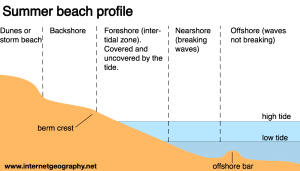Landforms of Coastal Deposition Flashcards
A sandy beach is usually formed in a sheltered bays, where low energy, constructive waves transport material onto the shore.
Find out more about landforms of coastal deposition.
A bar is a ridge of sand or single that joins two headlands either side of a bay.
Find out more about landforms of coastal deposition.
A bar is created when there is a gap in the coastland with water in it. This could be a bay or a natural hollow in the coastland. The process of longshore drift occurs and this carries material across the front of the bay. Material is pushed up onto beaches at a 45-degree angle when the swash brings it onto the coastline. The backwash takes it back out towards the sea at a right angle to the coast. Through this process, the material is constantly moved along the coastline. The deposited material eventually joins up with the other side of the bay and a strip of deposited material blocks off the water in the bay. The area behind the newly formed bar is known as a lagoon.
Find out more about landforms of coastal deposition.
Beaches, sand dunes, spits and bars.
Find out more about landforms of coastal deposition.

